 We had to get up early today for our visit to the Great Wall of China (萬里長城). The day before, we booked seats with the travel agent in our hotel for a package tour to the Great Wall and Ming Tombs (明朝十三陵). The price was RMB150 which we felt was a good deal since it included transportation, entrance to the sites, and lunch.
We had to get up early today for our visit to the Great Wall of China (萬里長城). The day before, we booked seats with the travel agent in our hotel for a package tour to the Great Wall and Ming Tombs (明朝十三陵). The price was RMB150 which we felt was a good deal since it included transportation, entrance to the sites, and lunch.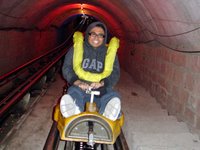 There were optional fees which included RMB60 for a slide car ride up the mountain and down back; as well as RMB40 for extra sites which we could not get the agency to explain in English. So we opted for the slide car ride. Another option up the mountain was a cable car ride but the tour they offered did not have that option since the drop off point for the cable car was in another part of the Great Wall.
There were optional fees which included RMB60 for a slide car ride up the mountain and down back; as well as RMB40 for extra sites which we could not get the agency to explain in English. So we opted for the slide car ride. Another option up the mountain was a cable car ride but the tour they offered did not have that option since the drop off point for the cable car was in another part of the Great Wall. Anyway, the bus passed by for us in the hotel at 7:15 a.m. and there were already other passengers. The sad thing was the guide was speaking in Chinese since it turns out, we were the only foreigners on the bus.
Anyway, the bus passed by for us in the hotel at 7:15 a.m. and there were already other passengers. The sad thing was the guide was speaking in Chinese since it turns out, we were the only foreigners on the bus.On the way, one of the passengers started a shouting match with the guide. We had figured that it had something to do with the payment since the guides were doing rounds of the passengers collecting money. It turns out, the optional fees were not optional and they were collecting the said fees from those who did not pay. So that’s why one of the passengers got hysterical since she thought it was optional and didn’t want to pay for it. So we too had to pay the RMB40 which we opted not to take. Oh well!
 The northern pass of Juyongguan Pass is known as Badaling. This particular area of the Great Wall is the most visited by tourists. This portion of the Great Wall is 7.8 meters high and 5 meters wide.
The northern pass of Juyongguan Pass is known as Badaling. This particular area of the Great Wall is the most visited by tourists. This portion of the Great Wall is 7.8 meters high and 5 meters wide.As we neared Badaling, the view outside of the tall mountains and traces of the Great Wall was just awe-inspiring. When we exited the bus at the drop off point, a gush of frigid wind hit us. We completely forgot that it was much colder here than the city proper since we were high up in the mountains. It was so cold that I had to put on my hood to keep my ears warm. I should have purchased gloves the day before since the stalls were selling them at exorbitantly high prices. So I had to make do with the pouch in my sweater to keep my hands warm.
 The Great Wall of China (萬里長城) was built to protect the various dynasties from raids by Hunnic, Mongol, Turkic, and other nomadic tribes coming from areas in modern-day Mongolia and Manchuria. Although several walls were built since the 3rd century BC, the most famous being built between 220 BC and 200 BC by the first emperor of China, Qin Shi Huang, little of those earlier walls remain. It is the world's longest man-made structure, stretching over 6,352 kilometers. Mao Zedong had a saying: 不到長城非好漢, "You're not a hero if you haven't climbed the Great Wall."
The Great Wall of China (萬里長城) was built to protect the various dynasties from raids by Hunnic, Mongol, Turkic, and other nomadic tribes coming from areas in modern-day Mongolia and Manchuria. Although several walls were built since the 3rd century BC, the most famous being built between 220 BC and 200 BC by the first emperor of China, Qin Shi Huang, little of those earlier walls remain. It is the world's longest man-made structure, stretching over 6,352 kilometers. Mao Zedong had a saying: 不到長城非好漢, "You're not a hero if you haven't climbed the Great Wall." We boarded the slide cars up the mountain which brought us straight to the entrance of the Great Wall. This was the third UNESCO World Heritage Site I visited in just two days. I guess my high spirits just overtook me as I walked the wall and I didn’t realize I had walked a long distance already. The wall stretched as far as the eye could see. The experience was just surreal.
We boarded the slide cars up the mountain which brought us straight to the entrance of the Great Wall. This was the third UNESCO World Heritage Site I visited in just two days. I guess my high spirits just overtook me as I walked the wall and I didn’t realize I had walked a long distance already. The wall stretched as far as the eye could see. The experience was just surreal. The guides gave us an hour and a half to do our thing. Then we were off to the next destination. I thought our next stop was lunch but we were herded into a jewelry shop, and after that, a sort of food supermarket which sold vacuum-packed Peking duck, dried fruits, pastries and breads and the like. Lunch was beside the supermarket which I was not satisfied with since it was mostly rice and vegetables. So I ended up buying corn and a grilled sausage from the vendors outside.
The guides gave us an hour and a half to do our thing. Then we were off to the next destination. I thought our next stop was lunch but we were herded into a jewelry shop, and after that, a sort of food supermarket which sold vacuum-packed Peking duck, dried fruits, pastries and breads and the like. Lunch was beside the supermarket which I was not satisfied with since it was mostly rice and vegetables. So I ended up buying corn and a grilled sausage from the vendors outside.I would later read in Wikitravel a warning about tours being touted in the Forbidden City area with prices between RMB100 to 150 since these tours earned from commissions from all these outlets they bring their passengers to. Although ours was legitimate since it came from our hotel travel agency, I figured our tour was cheap since they earned if any of the passengers bought from the shops they brought us to.
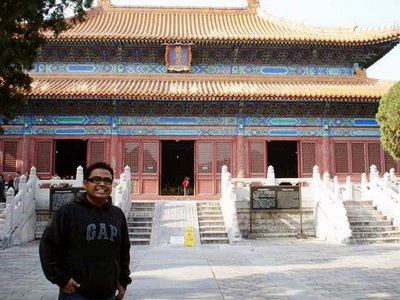 After lunch, we went to one of the Ming Tombs (明朝十三陵). There are thirteen imperial tombs of the Ming Dynasty scattered in an area of about 40 square kilometers in the Changping District of Beijing. They were inscribed in the UNESCO World Heritage List in 2003.
After lunch, we went to one of the Ming Tombs (明朝十三陵). There are thirteen imperial tombs of the Ming Dynasty scattered in an area of about 40 square kilometers in the Changping District of Beijing. They were inscribed in the UNESCO World Heritage List in 2003.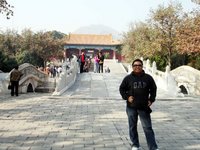 It was the Yongle Emperor, the third Ming emperor, who chose the site of the Ming Tombs. Ruling from 1402 to 1424, he was responsible for moving the capital from Nanjing to Beijing and is credited with envisioning the layout of the ancient city of Beijing. After the construction of the Forbidden City in 1420, Yongle selected his burial site and created his own mausoleum. All in all, 13 out of 16 Ming Dynasty emperors were buried in the area. The tombs of the first two Ming Emperors are located near Nanjing, the capital city during their reigns.
It was the Yongle Emperor, the third Ming emperor, who chose the site of the Ming Tombs. Ruling from 1402 to 1424, he was responsible for moving the capital from Nanjing to Beijing and is credited with envisioning the layout of the ancient city of Beijing. After the construction of the Forbidden City in 1420, Yongle selected his burial site and created his own mausoleum. All in all, 13 out of 16 Ming Dynasty emperors were buried in the area. The tombs of the first two Ming Emperors are located near Nanjing, the capital city during their reigns. Only three tombs are open to the public namely Changling, Dingling and Zhaoling. Of these, only the tumulus (underground chamber) of the Dingling Tomb has been opened. Chinese archaeologists are excited about opening the Changling tumulus housing the powerful Yongle Emperor and possibly containing the remaining copy of the Great Dictionary of Yongle (Yongle Dadian).
Only three tombs are open to the public namely Changling, Dingling and Zhaoling. Of these, only the tumulus (underground chamber) of the Dingling Tomb has been opened. Chinese archaeologists are excited about opening the Changling tumulus housing the powerful Yongle Emperor and possibly containing the remaining copy of the Great Dictionary of Yongle (Yongle Dadian).We visited the Zhaoling Tomb (昭陵) of Zhu Zaihou (朱載垕), also known as Emperor Muzong (穆宗) or the Longqing Emperor (隆慶) and his three empresses. His reign lasted only six years from1566 to 1572. It wasn't the best of the Ming Tombs though and I felt our guides were just being wise since it had the cheapest entrance fee at RMB30. As they say, "If you've seen one, you've seen them all." Hehe!
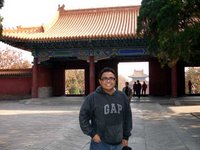 Anyway, after a brief tour of the tomb, we were back to the bus. I was expecting that the extra site was another Ming Tomb but instead they brought us to a wax museum about the Ming Dynasty. Since I’ve seen so many museums before, I would have wanted to stay in the bus and save my money but the guide refused since I think they paid a group rate. So obviously, they were also able to earn from that.
Anyway, after a brief tour of the tomb, we were back to the bus. I was expecting that the extra site was another Ming Tomb but instead they brought us to a wax museum about the Ming Dynasty. Since I’ve seen so many museums before, I would have wanted to stay in the bus and save my money but the guide refused since I think they paid a group rate. So obviously, they were also able to earn from that.But the museum was not bad since the life-size dioramas were really great and thanks to the English translations of the various scenes, I was able to learn a lot. It was just that I would have wanted to spend the RMB40 on another Ming Tomb.
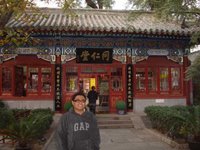 With that done, the group went back to central Beijing. I thought the tour was over but they brought us to one last stop. We went to a traditional Chinese drugstore next which was called the Beijing Tongrentang. I felt it was consistent with the Wikitravel warning. Hehe! They were giving a lecture but it was in Chinese so we were able to excuse ourselves from the sales talk which I felt they were doing in there. But the building had a lot of history since it provided medicine for royalty since 1723. It even had the golden dragon on its ceiling, a sign that it served the emperor.
With that done, the group went back to central Beijing. I thought the tour was over but they brought us to one last stop. We went to a traditional Chinese drugstore next which was called the Beijing Tongrentang. I felt it was consistent with the Wikitravel warning. Hehe! They were giving a lecture but it was in Chinese so we were able to excuse ourselves from the sales talk which I felt they were doing in there. But the building had a lot of history since it provided medicine for royalty since 1723. It even had the golden dragon on its ceiling, a sign that it served the emperor.On the way to the Tongrentang, we saw a tourist information office right beside what looked like Beihai Park. So we told the guides that we would stay behind. From there, we walked towards the office and asked some questions. Got myself a better map of Beijing. Rhea and Marlon wanted to go shopping since it was their last chance. While I wanted to check out the park. So from there, we parted ways and did our own thing.

Looks like you had a great time. The slide car looks like fun! I will definetly try it when I go. Btw, I just found a new travel site, baraaza.com. I think you will like it.
ReplyDeleteSo which travel agent did you go to ? Is it in the Phils? Let me know coz your experience sounds interesting
ReplyDelete